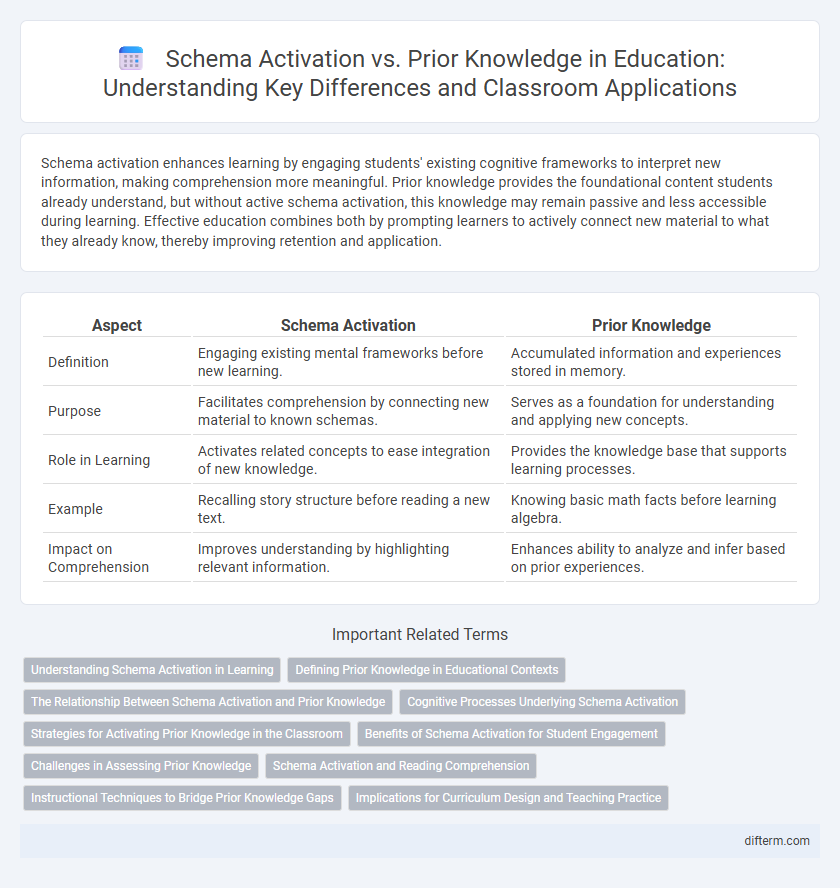Schema activation enhances learning by engaging students' existing cognitive frameworks to interpret new information, making comprehension more meaningful. Prior knowledge provides the foundational content students already understand, but without active schema activation, this knowledge may remain passive and less accessible during learning. Effective education combines both by prompting learners to actively connect new material to what they already know, thereby improving retention and application.
Table of Comparison
| Aspect | Schema Activation | Prior Knowledge |
|---|---|---|
| Definition | Engaging existing mental frameworks before new learning. | Accumulated information and experiences stored in memory. |
| Purpose | Facilitates comprehension by connecting new material to known schemas. | Serves as a foundation for understanding and applying new concepts. |
| Role in Learning | Activates related concepts to ease integration of new knowledge. | Provides the knowledge base that supports learning processes. |
| Example | Recalling story structure before reading a new text. | Knowing basic math facts before learning algebra. |
| Impact on Comprehension | Improves understanding by highlighting relevant information. | Enhances ability to analyze and infer based on prior experiences. |
Understanding Schema Activation in Learning
Schema activation enhances learning by connecting new information to existing cognitive frameworks, improving comprehension and retention. Prior knowledge serves as the foundation for schema activation, enabling learners to better organize and integrate new concepts. Effective instructional strategies that trigger appropriate schemas facilitate deeper understanding and meaningful learning experiences.
Defining Prior Knowledge in Educational Contexts
Prior knowledge in educational contexts refers to the information, skills, and experiences that learners bring to new learning situations, serving as a cognitive foundation for integrating new content. It encompasses both explicit knowledge, such as facts and concepts previously learned, and tacit knowledge gained from personal experiences. Activating this prior knowledge through instructional strategies enhances comprehension, retention, and the ability to apply new information effectively.
The Relationship Between Schema Activation and Prior Knowledge
Schema activation enhances the retrieval and application of prior knowledge by aligning new information with existing cognitive frameworks. Effective schema activation supports deeper understanding and retention by facilitating connections between unfamiliar concepts and previously learned material. Research indicates that the strength of prior knowledge directly influences the efficiency of schema activation during learning processes.
Cognitive Processes Underlying Schema Activation
Schema activation involves the cognitive process of retrieving and organizing prior knowledge structures to interpret new information efficiently. Neural mechanisms such as pattern recognition and associative memory retrieval facilitate the integration of relevant schemas during learning. Prior knowledge serves as a foundation enabling schema activation, enhancing comprehension, problem-solving, and memory consolidation in educational contexts.
Strategies for Activating Prior Knowledge in the Classroom
Effective strategies for activating prior knowledge in the classroom include using graphic organizers, KWL charts (Know, Want to know, Learned), and interactive discussions that connect new content to students' existing experiences. Employing questioning techniques such as open-ended questions and think-pair-share encourages deeper cognitive engagement, facilitating schema activation that enhances comprehension and retention. Incorporating multimedia resources and real-world examples further reinforces connections between prior knowledge and new learning, optimizing educational outcomes.
Benefits of Schema Activation for Student Engagement
Schema activation enhances student engagement by connecting new information to existing knowledge frameworks, facilitating deeper understanding and retention. Activating prior knowledge stimulates cognitive processes, making learners more attentive and motivated during lessons. This strategy supports personalized learning experiences, promoting active participation and improved academic outcomes.
Challenges in Assessing Prior Knowledge
Assessing prior knowledge presents challenges due to students' varied schema activation, which influences their ability to recall and apply relevant information. Inaccurate or incomplete schema activation can result in underestimating a learner's true understanding and readiness for new content. Educators must employ diverse assessment strategies to differentiate between gaps in knowledge and difficulties in schema retrieval.
Schema Activation and Reading Comprehension
Schema activation enhances reading comprehension by enabling readers to connect new information with existing cognitive frameworks, facilitating deeper understanding and retention of text. Effective schema activation strategies prompt readers to recall relevant prior knowledge, which supports inference-making and improves overall text interpretation. Research shows students who engage in schema activation before reading demonstrate higher comprehension scores and better critical thinking skills.
Instructional Techniques to Bridge Prior Knowledge Gaps
Instructional techniques that effectively bridge prior knowledge gaps include activating schema through concept mapping, collaborative discussions, and multimedia integration to create meaningful connections with new content. Utilizing formative assessments identifies learners' existing knowledge and misconceptions, allowing educators to tailor instruction and scaffold learning. Differentiated instruction that incorporates real-world examples and analogies enhances schema activation, facilitating deeper understanding and retention of new information.
Implications for Curriculum Design and Teaching Practice
Schema activation enhances learning by connecting new content to students' existing cognitive frameworks, optimizing comprehension and retention. Curriculum design should integrate strategies that explicitly trigger relevant prior knowledge to facilitate deeper engagement and scaffold complex concepts. Teaching practices must focus on diagnosing students' pre-existing schemas and tailoring instructional methods to bridge gaps, thereby promoting meaningful knowledge construction.
schema activation vs prior knowledge Infographic

 difterm.com
difterm.com